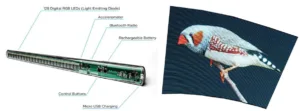Electricks (San Francisco, CA) is developing a product called Trickstick. The device is a hand held “persistence of vision” display in the form of a wand. “Wave it in front of you and a colorful, detailed image appears out of thin air.”
The operating principle of the Trickstick is based on the fact that, due to persistence of vision, the human visual system will integrate a rapid succession of discrete images into a single image. The “decay time constant” of the integration varies depending on the extent to which the user’s eyes have dark adapted.
There are 128 linear “pixels” in the Trickstick wand. Each pixel is a 1.0 millimeter square composed of RGB LEDs. The pixels are spaced 1.5 millimeters apart resulting in a display length of about 7.5-inches (19cm). The LEDs are turned on or off every 15 nanoseconds. An accelerometer contained within the Trickstick determines the details of how the wand is waved. Based on the accelerometer data, a microprocessor adjusts the triggering and synchronization of the display timing to match the motion of the user’s arm. More specifically, the display driver adjusts the brightness of each LED, the on-time and the current for each pixel in each column and does so at the proper time. This ensures that the viewer will see all the LED-pixel columns/lines spread out one after the other and thus produce a quality image that can appear to “float in space.”
The battery in the Trickstick is a single 18650 Li-Ion cell that provides about a full day of wand use. The device can be recharged with a micro-USB plug.
A Bluetooth 4.2 Low Energy radio connection allows the images, photos and animated GIFs resident in the Trickstick to be updated wirelessly from an Android or iOS app that the user must download into their smartphone.
Two buttons on the front of the wand allow navigation through the smartphone’s photo gallery. The buttons also allow several simple display mode and parameter adjustments such as to the image brightness, the trigger/synchronization modes and the display rate.
Additional Trickstick device specifications include the following:
- 24 bit full color display
- Contrast ratio is 4096:1
- Maximum line rate >13 kHz
- Maximum frame rate > 60 fps – if your arm can swing the wand that fast!
- 13-inch total physical wand length
Electricks suggests that the Trickstick can be used for a variety of applications that include the following:
- Entertainment: play animations in real time and in real space.
- Promotion: attract attention.
- Protest: adapt a message quickly to the evolving situation.
- Direct traffic.
- Light-painting: “With 1.5mm pixel spacing, it is possible to work close to a camera while maintaining high resolution detail. In addition, the output line rate is so fast that it is possible to capture an image without the need for a long exposure.”
- Live performance
A video can be found at the end of this article that shows the Trickstick in operation.
The Trickstick team embraces the obvious by noting that there are differences between the characteristics of the human visual system, some of which were mentioned above, and those of a video camera and that these differences can lead to the presence of artifacts in the image produced by the Trickstick. A video camera operates at a specific frame rate (typically 60 frames per second) and does not smoothly or continuously integrate the image. As a result, when humans view a Trickstick video image, there can be distracting artifacts due to the mismatch between the rate at which the Trickstick is operating (and being waved) and the video frame rate. Such artifacts include dark stripes, flickering and the introduction of jaggedness into the image. Note, however, that given a video that is captured at a sufficiently high frame rate and with careful post processing, it becomes possible for the Trickstick to produce a “much more realistic image.”
The next step for the company in the commercialization of the Trickstick is reported as the need to procure injection mold tooling for the case and to engage consulting assistance in refining the Android and iOS apps. After this, the company will place an initial production order with a California-based contract manufacturer. To fund these next steps, the company has launched a Kickstarter campaign which can be found here. At the time this article is written, 446 backers have pledged a total of $59,258 towards a goal of $98,000. The project will be funded if the goal is reached by December 1st. -Arthur Berman

